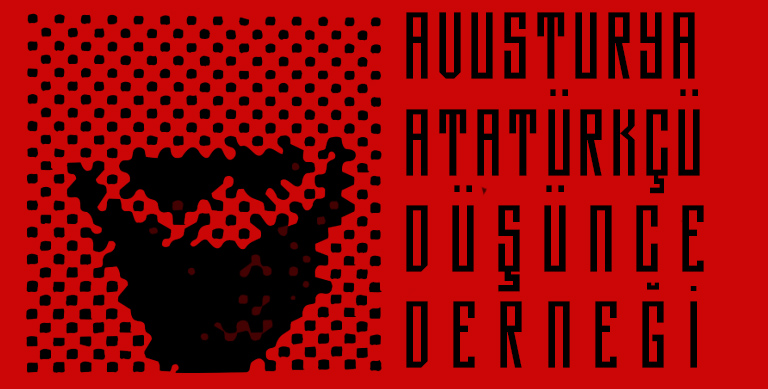Ataturk’s life
MUSTAFA KEMAL ATATURK
(1881 – ∞)
FOUNDER AND FIRST PRESIDENT OF THE REPUBLIC OF TURKEY MUSTAFA KEMAL ATATÜRK was born in 1881 in Thessaloniki in a three-storey pink house in Kocakasim Mahallesi, Islahhane Caddesi. His father is Ali Rıza Efendi and his mother is Zübeyde Hanım. His paternal grandfather Hafız Ahmet Efendi XIV-XV. It is one of the Kocacık nomads who settled from Konya and Aydın in Macedonia over the centuries. His mother, Zübeyde Hanım, is the daughter of an old Turkish family based in the city of Langaza near Thessaloniki. Ali Rıza Efendi, a militia officer, foundation official and timber merchant, married Zübeyde Hanım in 1871. Four of Atatürk’s five siblings died young, only Makbule (Atadan) lived until 1956.
When little Mustafa came of age, he started his education at Hafız Mehmet Efendi’s neighborhood school, then he transferred to Şemsi Efendi School at his father’s request. Meanwhile he lost his father (1888). After spending some time with his uncle at Rapla Farm, he returned to Thessaloniki and finished his schooling. He enrolled in Thessaloniki Civil High School. After a short time he entered the military high school in 1893. In this school, the math teacher Mustafa Bey added “Kemal” to his name. He graduated from Manastır Military High School in 1896-1899 and began his education at Istanbul Military Academy. In 1902 he graduated with the rank of lieutenant. He attended the military academy. He graduated from the academy on January 11, 1905 with the rank of captain. Between 1905 and 1907 he served in Damascus under the command of the 5th Army. In 1907 he became Kolağası (Senior Captain). Monastery III. He was assigned to the army. On April 19, 1909, he took office as Chief of Staff of the Movement Army that invaded Istanbul. In 1910 he was sent to France. He took part in the Picardy maneuvers. In 1911 he began to work under the command of the General Staff in Istanbul.
In the war that began with the Italian attack on Tripoli in 1911, Mustafa Kemal and a group of his friends took the lead in the Tobruk and Derne regions. He won the Battle of Tobruk against the Italians on December 22, 1911.
When the Balkan War began in October 1912, Mustafa Kemal joined the war with the troops in Gallipoli and Bolayır. His great merits were seen in the reconquest of Dimetoka and Edirne. In 1913 he was appointed attaché of Sofia. In this capacity he was promoted to lieutenant colonel in 1914. His military attaché ended in January 1915. In the meantime, World War I started and the Ottoman Empire was forced to enter the war. Mustafa Kemal was assigned to Tekirdag to form the 19th Division.
During World War I, which began in 1914, Mustafa Kemal wrote a heroic epic in Çanakkale and said to the Entente powers: “Canakkale is impossible! ” he said. When on March 18, 1915, the British and French navies suffered heavy losses while attempting to cross the Dardanelles Strait, they decided to land troops on the Gallipoli peninsula. On April 25, 1915, the enemy forces held , who had landed at Arıburnu, the 19th Division under the command of Mustafa Kemal, attacked at Conkbayırı.After this success, Mustafa Kemal was promoted to the rank of colonel.British attacked again at Arıburnu on 6-7 August 1915 . Anafartalar group commander Mustafa Kemal won the Anafartalar victory on August 9 and 10. This victory on August 17 Kireçtepe, on August 21 II Anafartalar followed the victories.The Turkish nation that gave 253,000 martyrs in the Dardanelles wars, knew how to protect their honor against the Entente powers Mustafa Kemal’s command to his soldiers “I do not order you to attack, I order you to die!” changed the fate of the front.
After the Çanakkale Wars, Mustafa Kemal took over the command in Edirne and Diyarbakır in 1916. In April 1916 he was promoted to major general. He fought against the Russian forces and ensured the recapture of Muş and Bitlis. After brief assignments in Damascus and Aleppo, he came to Istanbul in 1917. He went to Germany with Velihat Vahidettin Efendi and conducted investigations at the front. He became ill after this trip. He went to Vienna and Karisbad for treatment. He returned to Aleppo on August 15, 1918 as commander of the 7th Army. On this front he fought successful defensive battles against British forces. On October 31, 1918, a day after the signing of the Mudros Armistice, he was appointed Commander of Army Group Yıldırım. After the abolition of this army, he came to Istanbul on November 13, 1918 and began to work in the Ministry of War.
After the Armistice of Mudros, the Entente States began to occupy the Ottoman armies; Mustafa Kemal landed in Samsun on May 19, 1919 as inspector of the 9th Army. With the circular published in Amasya on June 22, 1919, he declared that “the determination and decision of the nation will save the independence of the nation” and called the Sivas Congress into session. He convened the Erzurum Congress between July 23 and August 7, 1919 and the Sivas Congress between September 4 and 11, 1919 and determined the path to the liberation of the fatherland. On December 27, 1919, he was enthusiastically received in Ankara. With the opening of the Turkish Grand National Assembly on April 23, 1920, an important step was taken towards the founding of the Turkish Republic. Mustafa Kemal was elected Chairman of the Assembly and the Government. The Turkish Grand National Assembly passed and began implementing the necessary laws for the successful conclusion of the War of Independence.
The Turkish War of Independence began on May 15, 1919, when the first bullet was fired at the enemy during the Greek occupation of Izmir. With the signing of the Treaty of Sèvres on August 10, 1920, militia forces called Kuva-yi Milliye fought against the victorious states of World War I, who divided the Ottoman Empire among themselves. The Grand National Assembly of Turkey established the regular army, achieved the unity of the Kuva-yi Milliye and the army, and ended the war in victory.
The main stages of the Turkish War of Independence under Mustafa Kemal are as follows:
Sarikamis (September 20, 1920)
Cukurova, Gazi Antep, Kahraman Maras Sanli Urfa Defense (1919-1921)
- İnönü Victory (6-10 January 1921)
- İnönü Victory (March 23 – April 1, 1921)
Sakarya Victory (23 August – 13 September 1921)
The Great Offensive, the Battle of the Commander-in-Chief, and the Great Victory (August 26 – September 9, 1922)
After the victory of Sakarya on September 19, 1921, the Turkish Grand National Assembly bestowed the rank of Marshal and the title of Gazi on Mustafa Kemal. The War of Independence ended with the Treaty of Lausanne signed on July 24, 1923. Thus, nothing stood in the way of establishing a new Turkish state on the basis of national unity on the territory of Turkey, which was shattered by the Treaty of Sèvres and left the Turks with a homeland of 5-6 provinces.
The founding of the Republic of Turkey began with the opening of the Turkish Grand National Assembly on April 23, 1920 in Ankara. The Assembly’s successful leadership of the Turkish War of Independence accelerated the establishment of the new Turkish state. On November 1, 1922, the Caliphate and the Sultanate were separated and the Sultanate was abolished. This severed the administrative ties to the Ottoman Empire. The administration of the republic was adopted on October 13, 1923, and Atatürk was unanimously elected as the first president. The first government of the republic was established by İsmet İnönü on October 30, 1923. The Republic of Turkey began to rise on the foundations of “Sovereignty belongs unconditionally to the nation” and “Peace at home, peace in the world”.
Ataturk carried out a series of revolutions to “elevate Turkey to the level of contemporary civilization”. These revolutions can be summarized under five headings:
- Political revolutions: Abolition of the Sultanate (November 1, 1922) Proclamation of the Republic (October 29, 1923) Abolition of the Caliphate (March 3, 1924)
- Social revolutions: Equal rights for women and men (1926-1934) Hat and dress revolution (November 25, 1925) Closing of lodges and graves (November 30, 1925) Family name law (June 21, 1934) Abolition of nicknames and titles (November 26, 1925 ). 1934) International measurement of time, calendar and length (1925-1931)
- Legal Revolution: Abolition of the Mecelle (1924-1937) Transition to the secular legal system through the enactment of the Turkish Civil Code and other laws (1924-1937)
- Revolutions in Education and Culture: Unification of Education (March 3, 1924) Adoption of New Turkish Scripts (November 1, 1928) Establishment of Institutes of Turkish Language and History (1931-1932) Organization of University Education (May 31, 1933) Innovations in the small arts
- Revolutions in the field of economy: abolition of tithes · promotion of farmers · establishment of model businesses · founding of commercial enterprises through the enactment of the Commercial Promotion Act · I. and II. Implementation of the development plans (1933-1937), equipping the country with new roads
In accordance with the Surname Law, on November 24, 1934, Mustafa Kemal was bestowed the surname “Atatürk” by the Turkish Grand National Assembly.
Atatürk made frequent land trips and oversaw the work of the state on the ground. He gave orders to those affected about the deficient aspects. It hosted the heads of state, prime ministers, ministers and commanders of foreign countries visiting Turkey in their capacity as President.
On October 15-20, 1927, he gave his great speech on the War of Independence and the founding of the Republic, and on October 29, 1933, his 10th anniversary speech.
Ataturk lived in simplicity in his personal life. He married Latife Hanım on January 29, 1923. Together they undertook many country trips. This marriage lasted until August 5, 1925. Atatürk, who was very fond of children, adopted daughters named Afet (İnan), Sabiha (Gökçen), Fikriye, Ülkü, Nebile, Rukiye, Zehra and a shepherd named Mustafa. He took the children named Abdurrahim and İhsan under his protection. He prepared a good future for his livelihood.
In 1937 he donated his farms to the treasury and some of his real estate to the municipalities of Ankara and Bursa. He allocated part of his inheritance to his sister, adopted children and institutions of Turkish language and history. He loved reading, listening to music, dancing, horseback riding and swimming. He was very interested in Zeybek dances, wrestling and Rumelian folk songs. He enjoyed playing backgammon and billiards. He was very fond of his dog Fox with his horse named Sakarya. He had a rich library. He invited statesmen, scientists, artists to dinner and discussed the country’s problems. He used to wear neat and tidy. He loved nature very much. He often went to Atatürk Forest Farm and personally participated in the work.

